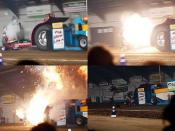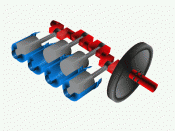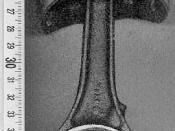Introduction
This work is focusing on torsional vibrations in marine propulsion systems, the problems that occur and the means that today's technology has in order to overcome them. Marine prime mover power plants and propulsion powering arrangements will be analyzed from the scope of torsional vibration as well.
1.0Torsional vibrations
Naval architects and propeller designers have often been faced with the problem of propeller and machinery, such as gear gearboxes, induced vibration. It is therefore; more important to prevent a vibration problem than attempt to cure it after it occurs.
Prevention of shipboard vibration (not only torsional) has become more important now than ever before, not only because it is necessary to ensure more comfort for those who sail on board the ship, but also because of the instrumentation necessary for the ships automation, such as computers, sensors and other sensitive equipment.
The sources of torsional vibration of marine transmission systems are:
*Inertia forces on moving parts including propellers, gears, crank shafts, etc.
*Periodic variations in gas pressure.
The process of dealing with torsional vibration problem are:
*Modeling
*Natural frequency determination and vibration magnitudes at natural frequencies.
*Identification of sources of torsional excitations.
*Damping
*Control of vibrations.2
2.0Ships prime mover engine plants.
Prime mover engine plant refers to the plant that it used to move the ship. There are a number of different prime mover engine systems that are used in ships. The three major types of power plants shown below and these will be analyzed in this article.
*Marine Diesel engine plant
*Marine steam turbine plant
*Marine gas turbine plant
2.1.0 Marine Diesel engine.
Each time the air/fuel mixture inside a cylinder is ignited, the combustion that results creates an extremely rapid rise in cylinder pressure. This pressure, applied to the top of the piston, becomes the...


